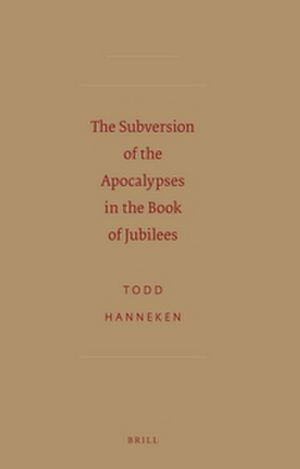

Hardcover
-
PICK UP IN STORECheck Availability at Nearby Stores
Available within 2 business hours
Related collections and offers
Overview

Product Details
| ISBN-13: | 9789004219809 |
|---|---|
| Publisher: | Brill Academic Publishers, Inc. |
| Publication date: | 08/15/2012 |
| Series: | SBL - Early Judaism and Its Literature , #34 |
| Pages: | 331 |
| Product dimensions: | 6.30(w) x 9.30(h) x 0.90(d) |
About the Author
Table of Contents
Preface Abbreviations1. Introduction
1.1. Th e Problem
1.1.1. Overestimating the Similarity to the Apocalypses
1.1.2. Underestimating the Similarity to the Apocalypses
1.2. Th e Solution
1.2.1. Distinguish Layers of Abstraction: Literary Morphology, Typical Ideas, and Social Context
1.2.2. Defi ne the Genre Based on Literary Morphology
1.2.3. Other Layers Follow: Ideas, Social Movements, and Function
1.2.4. Jubilees Uses the Typical Literary Morphology to Express Atypical Ideas
1.3. Introductory Examples of Subversion
1.3.1. Survey of Pervasive and Structurally Significant Use of the Literary Genre
1.3.2. Evil, Injustice, and the Lack Th ereof
1.3.3. Eschatology
1.3.4. Conclusion
2. Th e Spatial Axis
2.1. Angels and Demons
2.1.1. Before the Flood: Th e Origin of Evil
2.1.1.1. Th e Enochic Apocalypses
2.1.1.2. Th e Danielic Apocalypses
2.1.1.3. Jubilees
2.1.2. Aft er the Flood: Th e Persistence of Demons
2.1.2.1. Th e Early Apocalypses
2.1.2.2. Jubilees
2.1.3. Angelic Mediation
2.1.3.1. Evidence outside the Apocalypses
2.1.3.2. Th e Early Apocalypses
2.1.3.3. Jubilees
2.1.4. Th e Leader of Evil
2.1.4.1. Terms, Names, and Titles
2.1.4.2. Satan in Nonapocalypse Received Scriptures
2.1.4.3. Th e Early Apocalypses
2.1.4.4. Mastema in Jubilees
2.1.5. Angels and Demons in the Eschatological Crisis and Restoration
2.1.5.1. Th e Early Apocalypses
2.1.5.2. Jubilees
2.2. Humans
2.2.1. Groups
2.2.1.1. Th ird Isaiah
2.2.1.2. Th e Enochic Apocalypses
2.2.1.3. Th e Danielic Apocalypses
2.2.1.4. Jubilees
2.2.2. Violence
2.2.2.1. Th e Enochic Apocalypses
2.2.2.2. Th e Danielic Apocalypses
2.2.2.3. Jubilees
3. Th e Temporal Axis
3.1. Th e Decline of History
3.1.1. Th e Enochic Apocalypses
3.1.2. Th e Danielic Apocalypses and the Book of Daniel
3.1.3. Jubilees
3.2. Th e Final Woes
3.2.1. Th e Enochic Apocalypses
3.2.2. Th e Danielic Apocalypses
3.2.3. Jubilees
3.2.3.1. Th e “Final Woes” Are Just Chastisement from God as Prescribed by the Covenant
3.2.3.2. Th e “Final Woes” Have Already Been Fulfi lled
3.2.3.3. Th e White Children
3.3. Th e Judgment
3.3.1. Th e Enochic Apocalypses
3.3.2. Th e Danielic Apocalypses and the Book of Daniel
3.3.3. Jubilees
3.3.3.1. Jubilees 23
3.3.3.2. Th e Judgment Discourse in Jubilees 5
3.3.3.3. Th e Role of Enoch in Judgment
3.3.3.4. Th e Judgment of Individual Nations
3.4. Th e Restoration
3.4.1. Th ird Isaiah
3.4.2. Th e Enochic Apocalypses
3.4.3. Th e Danielic Apocalypses and the Book of Daniel
3.4.4. Jubilees
3.4.4.1. Th e Restoration in Jubilees 23 Is Gradual and Has Already Begun
3.4.4.2. Jubilees 1:26–29 Identifi es the Indwelling of the Sanctuary in the Restoration with the Indwelling of the Sanctuary of Aaron
3.4.4.3. Th e Law Revealed at Sinai Will Not Be Surpassed
3.4.4.4. Th e Separation of the Israelites Was Planned from the Beginning
3.4.4.5. Th e Borders of the Land of Israel Will Be Restored, Not Dissolved
3.4.4.6. Th e Eschatological Calendar Will Restore, Not Replace, the Calendar Observed in the Past and in Heaven
3.5. Conclusion
4. Th e View of Revelation
4.1. Th e Use and View of Received Authority
4.1.1. Th e Enochic Apocalypses
4.1.1.1. Th e Use of Enochic Traditions
4.1.1.2. Th e Use of Non-Enochic Jewish Traditions
4.1.2. Th e Danielic Apocalypses
4.1.2.1. Th e Use of Danielic Traditions
4.1.2.2. Th e Use of Non-Danielic Jewish Traditions
4.1.3. Jubilees
4.1.3.1. Th e Heavenly Tablets
4.1.3.2. Departures from Genesis and Exodus
4.2. Th e Dependence of Revelation on Wisdom
4.2.1. Th e Enochic Apocalypses
4.2.2. Th e Danielic Apocalypses
4.2.3. Jubilees
4.2.3.1. Revelation without the Elitism of Wisdom
4.2.3.2. Revelation Made Unambiguous and Accessible
5. Explanation
5.1. Literary Insights into the Author’s Process
5.2. Literary Insights into the Audience’s Process
5.3. Historical Context
5.4. Cultural Context
5.5. Conclusion
Bibliography Index of Ancient Sources Index of Modern Authors Index of Subjects
